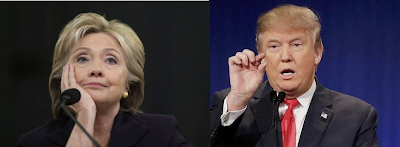Every four years I venture an educated guess as to who will win the Presidential election. Except for Bush vs. Kerry in 2004, which I declared to be a tossup, my record is spotless, at least in terms of the popular vote. This year isn't like any recent election year, however, so I am less confident than I usually am. I was certain, for instance, that Trump didn't have a prayer to win the G.O.P. nomination, but I (along with a lot of other people) were horribly mistaken. Thus, although I think Hillary will win the popular vote (and probably the electoral college), I am less certain in a long time. But I am getting ahead of myself.
For years I looked primarily to the state of the economy at election time (i.e., what I believe will be the state of the economy) for basing my conclusion. If the U.S. economy is doing well, it generally helps the incumbent party. It's not that a healthy economy affects the voting behavior of most voters, but it tends to exert a large influence on undecided voters, which are often the key to winning an election. A healthy economy helps incumbents more than it does the party, however; thus, while it looks like the economy will be relatively robust come November 8th ("The Economy Will Probably Be Pretty Good On Election Day"), it won't help Hillary as much as it would Obama if he were running.
Obama's increasing popularity should also help Hillary although how much is unclear. Hillary is very unpopular. Her unfavorability ratings would set records for a presidential nominee if it were not for the fact that her opponent's unfavorability ratings are even higher. As I noted in an earlier post, regardless of who wins, our next President will be very unpopular ("Our Next President Will Be Really Unpopular").
In recent years I've relied increasingly on prediction markets, which have been remarkably accurate in predicting the outcomes of presidential elections (see e.g., "Election Update"). Prediction markets are speculative markets created for the purpose of making predictions, and current market prices are interpreted as the probability of the outcome occurring. People make money in the markets by buying low and selling high. For example, currently the price of a share of Hillary Clinton sells for around $0.75, which means that if she wins, holders of shares in Hillary will receive $1.00 for each share they own. The price of a share is interpreted as the probability that someone will win. Thus, currently prediction markets believe that Hillary has a 75% of winning the election.
The prices for Hillary shares increased steadily after the close of the Democratic Convention, but after a couple of weeks, they began to fall (see chart above -- from PredictWise, which aggregates several prediction markets). It is tempting to attribute the rise after the convention to a "convention bump," but prediction markets tend to factor in such things, so most of the rise is probably due to Trump's several missteps, such as attacking the family of a fallen soldier, intimating that gun owners might have to take matters into their own hands if Trump loses, suggesting that Obama was the founder of a terrorist group that formed long before Obama was elected, and so on.
This year I'm also incorporating (Nate Silver's) FiveThirtyEight's election forecasts ("Who Will Win the Presidency?") into my prediction. These take into account poll data at the state and national levels. FiveThirtyEight has actually built three forecasting models: a polls-only forecast, a now-cast, and a polls-plus forecast. The first takes into account trends in recent polls; the second only looks to current polls; the third is similar to the first except that it factors in other factors, such as demographic, economic, and historical data (e.g., presidential races tend to tighten as they get closer to election day). The polls-plus tends to be the most conservative in that it reacts least to recent shifts in polling, while the now cast reacts the most. Below is the polls-plus graph predicting the probability of Clinton or Trump victory. Currently, the models predicts that there's a 70% chance that Hillary will win the election.
Taking all of these factors into account, I hesitantly (I haven't been this unsure in a long time) predict that, barring a major scandal (e.g., unforeseen email problems) or world event (e.g., another 9/11) Hillary Clinton should become the next President of the United States (as long as the electoral college follows the popular vote). She should win the popular vote by 3-5%, but if Trump reverts to shooting himself in the foot, she could win by more. That said, if Trump continues to reign his impulsiveness in, he may make it a lot closer. He could even win by a whisker.
Note: I wrote most of what appears in this post mid-August, but I decided to wait until after Labor Day, in order to give the polls time to settle down after the conventions.



No comments:
Post a Comment